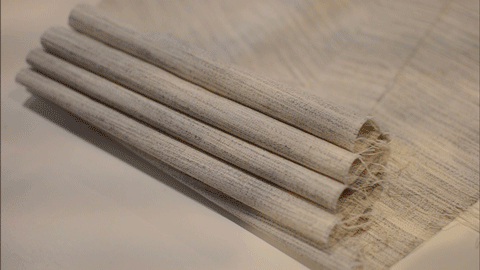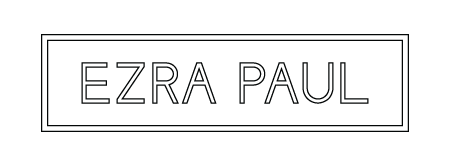Construction

Construction - how a garment is put together - is an extraordinarily important aspect of its ultimate quality. Every Ezra Paul jacket is hand-basted in Italy with a full, floating canvas
If you follow the blog, you’ve most likely encountered a post or two where I’ve deconstructed a suit jacket to show how it’s made. Unlike most other articles of clothing, the quality of a jacket is quite opaque. With a shirt, for instance, you can inspect the stitching and feel the fabric to get a pretty good idea of its quality. You can do the same with a jacket, but the guts – sandwiched between the lining and the fabric – play an extraordinarily important role in the drape, durability, breathability, and memory of the jacket. I’ve seen an increasing number of brands that are taking advantage of this by using good quality fabrics with poor construction, so the garment will appear to be of higher quality than it is.
Broadly speaking, there are two methods of jacket construction: fully-canvassed and fused (sometimes called half-canvassed or partially-canvassed).
Fully-Canvassed
Canvassing is the traditional way of adding structure to a jacket. Canvas is a thin - around 1.5 sheets of standard printer paper - and openly woven material consisting of some combination of horsehair, linen, and wool, depending on the manufacturer. Unlike paper, canvas has very good “memory,” which is a textile term used to describe the relative ability of a material to return to its original, post-processing state. Paper has poor memory - If you fold a sheet of paper in half and crease it, it will never lay flat again. Wool, on the other hand, is on the opposite end of the memory spectrum. This is why the wrinkles in a nice pair of wool dress pants will “shake” out on the hanger, but not in a pair of cotton chinos.

The canvas “floats” in the chest, moving independently of the outside fabric and inside lining, other than being tacked together in a few places. It must be carefully cut to conform to the shape of the jacket and requires basting (temporary stitching) to give the two-dimensional chest panel the third dimension of a torso. This is a laborious and costly process that requires years of experience to do correctly.
Fused/partially-canvassed/half-canvassed
In the mid-twentieth century, manufacturers started experimenting with different techniques that were less time consuming and thus less expensive. They eventually settled on a method called fusing, which is more akin to gluing or welding than sewing. Instead of floating a piece of canvas in the chest, a fused jacket employs a piece of synthetic cloth embedded with resins, referred to as a “fusible”. The fusible is placed on the backside of the jacket fabric and pressed with heat and steam, which melts the resins, allowing them to fuse with the fabric. This is the same process that’s used to attach an iron-on badge or patch a pair of jeans with hole in them (from a bygone era when holes were undesirable).
I’ve recently started noticing that some brands use misleading language to describe their fused garments by referring to them as either “partially-canvassed”, “half-canvassed” and even just “canvassed”. They can get away with this because virtually every jacket has a small piece of canvas located between the shoulder and the upper chest (for additional heft), which does not need to be basted and therefore doesn’t add much to the cost of manufacturing. Because there’s technically a piece of canvas, however small and ubiquitous, an unscrupulous brand can use these terms to hide the true quality of their jacket. It’s a subtle marketing trick and the only way to be sure that there isn’t any fusing in the jacket is to look for the words “full” or “fully” in conjunction with canvas.
Advantages and Disadvantages
To the untrained eye, canvassed and fused jackets can look comparable on the rack, but with closer inspection and wear, the differences become evident – similar to how the Vegas strip looks like Paris, Cairo, and New York City at first glance. As I've previously discussed in the deconstructed suit blog pieces, there are four main factors that determine the price of a suit or sport coat:
- Fabric - content, weave, mill, location
- Fabrication - how it's constructed
- Country of origin - where it's made
- Prestige - status of the brand
Prestige is hard to quantify, but of the other three categories, fabrication is by far the most opaque. You can look at a tag to find out where a garment is made and you can see and feel the fabric, but it is much harder to ascertain the quality of the fabrication. Today, most jackets are fused, including many expensive designer garments. Though knowledge about jacket construction has expanded with the proliferation of the internet, many consumers are not aware of the advantages and disadvantages associated with the different construction methods. So let’s spell them out:
Fusing Advantages:
- Less time consuming and thus cheaper to manufacture
- Potential to be less expensive to the consumer (see this Z Zegna blog post to see an example of when this is not the case)
Fusing Disadvantages:
- Limp/Less body – doesn’t hold shape and doesn’t “bounce back” after wearing
- Stiff – has a stiffer, often thicker feel
- More prone to wrinkling
- Not breathable – layer of synthetic polymer traps heat and moisture
- Can delaminate – fabric and fusing can separate and cause puckering, exacerbated by dry-cleaning
- Less durable
Canvas Advantages:
- Holds shape well – the springiness of the canvas helps the jacket drape properly and bounce back to its original shape
- More wrinkle resistant – because there isn’t fused backing, the jacket fabric isn’t impeded from utilizing its memory to flatten back out after wear
- Breathable – open-weaved, thin canvas does not retain heat and moisture
- Requires less cleaning – because it doesn’t retain moisture (e.g., sweat), it doesn’t get smelly as easily
- Lighter weight – canvas is thinner than fusible and not attached
- More durable – no resin on the backside of the fabric allows it to breath and wear better. Less dry-cleaning also increases durability
Canvas Disadvantages:
- More time consuming and therefore more costly to manufacture
- Generally more expensive to the consumer
If you’re interested in learning more about canvassing and fusing, check out the blog where there are several examples of deconstructed jackets from various brands and price-points.
